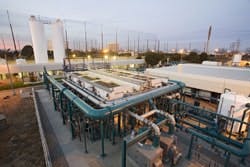The West Basin Municipal Water District in Carson, Calif., wholesales imported water to cities, mutual water companies, investor-owned utilities and private companies in South Bay and other unincorporated areas of Los Angeles County. The district serves a population of more than 900,000.
In 1995, West Basin constructed the West Basin Water Recycling Facility to meet the growing demand for a sustainable, reliable water supply in southern California and to reduce the demand on scarce potable water sources. West Basin became one of the first water agencies in the U.S. to implement wastewater reclamation using membrane technology.
Phased approach
In 1997, MEMCOR low-pressure membranes were installed at the recycling facility. The membrane system produced 2.5 mgd (395 m3/hr) of high quality water for reverse osmosis (RO) pretreatment.
The system worked so well that from 1998 through 2002, the district installed three additional MEMCOR systems to supply recycled water to the nearby Exxon Mobil and British Petroleum refineries as pretreatment to RO for boiler and cooling water feed.
By 2004, the district required an additional 11.7 mgd (1845 m3/hr) of low-pressure membrane filtration. Thus began the facility’s Phase IV expansion. Although West Basin had been using the MEMCOR Classic CMF pressurized membrane system for more than eight years, it opted to go with the MEMCOR CS , a submerged membrane system.
The Phase IV Expansion began in September 2006, using a MEMCOR CS submerged membrane system consisting of six membrane cells, each containing 384 modules. Each cell produces 2.4 mgd (379 m3/hr), allowing one cell to remain off-line to meet capacity demands.
When compared to the previous system, the MEMCOR CS provided a smaller footprint, lower operating costs, reduced waste production, increased flexibility and added the ability to visually inspect the membrane modules.
West Basin is now the largest facility of its kind in the U.S. treating more than 30 mgd (4732 m3/hr) of secondary effluent, which equals about eight billion gallons (30.3 x106 m3) of water annually for the South Bay. West Basin was also named “Large-Size Recycled Water Agency of the Year” by the California section of the WateReuse Association.
What began as a proactive measure to ease a potable water shortage has ultimately saved the region more than 65 billion gallons of drinking water.
Lisa Sorgini is the Global Marketing Manager for Memcor Products. She can be reached at (508) 849-4612 or by e-mail at [email protected] .


